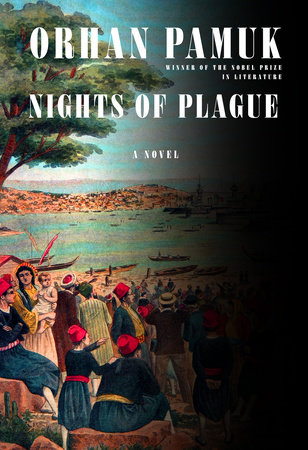
Pamuk’s latest translation from Turkish into English, Nights of Plague (coming out October 4th, 2022) is an epic both historical and contemporary. I need not remind anyone reading this that we are still, as a global community, navigating the Covid-19 pandemic (and monkey pox is making rounds again as well!) The timing must be viewed as deliberate; Pamuk’s commentary embedded within this novel can only be seen as prescient or proof of an uncanny insight into the human psyche as it relates to existential threat.
In short, Nights of Plague is epic.
The stories that unfolds within its pages are reminiscent of epic prose as well. Pamuk’s novel is spun around a royal Ottoman princess, Pakize and her husband, Prince Consort and medical doctor, Nuri; however, the tale is more accurately about the unravelling of a community and its denizens as they face possible annihilation and suffering from a breakout of plague. The locale of this event is a fictitious island, Mingheria, an outpost of the Ottoman empire that reflects the empire as a whole: multicultural in its constitution with ancient and new settlers of Greek, Muslim, Eastern European, African, Christian, and Colonial European descent; in precarious harmony with the multiple discordant voices, needs, and ambitions of politicians, medical professionals, ordinary citizens, foreign heads of state and their ambassadors, Ottoman royals, and immigrants; and gorgeous and complex in its rich history. Mingheria is a plague-beset limb of an empire popularly described as “the sick man.”
Pamuk’s tale of Mingheria does not confine itself to the accounts of elite royals, though it is ostensibly based on recently unearthed archival records and it is told as a historical monograph, through the eyes and pen of one of Princess Pakize’s descendants. Pamuk regales the reader with stories of its other denizens too: its merchants and common folk. There is the security guard of the local prison and the tale of him and his family as they struggle to survive and live their lives in the wake of plague and death. There are the doctors who work to eradicate the plague, demand quarantines. There is the governor too, all too human in his own ambition and fear.
Nights of Plague is about Mingheria and its people, how their present fears and dilemma(s) are shaped by their history of ethnic division and unity, religious and ideological differences, their universal humanity. They react based on their subjective desires, but are also creatures of their communities, their actions are shaped by the expectations of those around them, their enemies, their allies.
Our unknown narrator writes as a historian might do, providing context where necessary, but imbues the academic narrative with a novelist’s attention to texture, aroma, and the sensation of place. Mingheria is as real as the Ottoman Empire can be to a modern reader: the spicy, heady fragrance of a time and place that no longer exists is palpable.
Nights of Plague is a more gorgeous, more exotic — and historical — reflection of our own contemporary experience with Covid-19. The arguments between medical professionals, politicians, and the citizenry in this novel are all too familiar to anyone who has been watching the news for the past three years. The heated debates, the refusals to quarantine, the seeming indifference of the populace to the threat of death and suffering might make a reader feel queasy. The Lacanian recognition is jarring. But perhaps, for all of us, this is a necessary cognitive event in order to reconcile the past with the present and future. Pamuk delivers that lesson with poetic grace in Nights of Plague.
